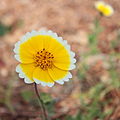- Layia platyglossa
-
Layia platyglossa 
Scientific classification Kingdom: Plantae (unranked): Angiosperms (unranked): Eudicots (unranked): Asterids Order: Asterales Family: Asteraceae Subfamily: Asteroideae Tribe: Heliantheae Genus: Layia Species: L. platyglossa Binomial name Layia platyglossa
( Fisch. & C.A.Mey.) A.GrayThe annual wildflower Layia platyglossa is called coastal tidy tips. Tidy tips is found throughout California's low-elevation dry habitats, from the coast to the low foothills and desert edges, and into Nevada, Utah and Arizona. [1]
Contents
Description
Its outer ray flowers are bright golden yellow with distinct, sharp-margined white tips. It is native to California and is a member of spring wildflower blooms in meadows and grasslands. It grows during the months of March to June. The tidy tips are an annual, glandular, daisy like plant with narrow, rough hairy leaves. The lower leaves are generally lobed and the upper leaves are entire. The flower heads are composed of five to eighteen yellow ray flowers with white tips and many central yellow disk flowers. It is common in grassy places at low elevations in grassy slopes and openings in coastal sage scrub, grasslands and chaparral, coastal plains.
The roots are usually taproots, sometimes fibrous. Stems are usually erect, sometimes prostrate to ascending. Leaves usually alternate or opposite, and the blades are usually simple, rarely compound. The plant is an indeterminate zygomorphic inflorescent, individual heads are borne on a peduncle. The florets are bisexual, pistillate, functionally staminate or neuter. The sepals are highly modified. The fruits are usually dry with thick, tough pericarps, sometimes rostrate and/or winged. Dispersion is done by the help from pappi (dispersal of fruit by wind). Pollination is done by insects. Seeds are one per fruit, embryos straight.
The stems are prostrate or decumbent and are stout and corymbed branched. The plant is one to three diameters long. The leaves at the upper part of the stem are short and have a pilous texture. The leaves at the basal part of the stem can be dentate to pinnate shaped with rotund short lobes. The bracts tips are rounded and involucre 6-12 mm high. The corolla is 4-6 mm long. The ray flowers are 3-3.8 mm long and the disk flowers are 2.8-5 mm long. The ligules are 6-15 mm long and 5-10 mm wide. The height of the entire plant is less than 1 foot, roughly around 1-3 diameters (4-12 inches).
Cultivation
Its daisy-like flowers are attractive, making it a popular garden ornamental plant and ingredient in commercial wildflower seed mixes. It is used in habitat gardens and restoration projects also.
Gallery
References
- ^ http://plants.usda.gov/java/profile?symbol=LAPL&mapType=nativity&photoID=lapl_002_ahp.tif USDA . accessed 11/10/2010
Munz, Philip A. Introduction to California Spring Wildflowers of the Foothills, Valleys, and Coast. California: University of California Press Berkeley, 2004. Abrams, Leroy, and Stinchfield, Roxana. Illustrated Flora of the Pacific States. Vol IV: Bignonias to Sunflowers. California: Stanford University Press, 1960. Schmidt, Marjorie G. Growing California Native Plants. California: University of California Press Berkeley, 1980.
External links
- Jepson Flora Project Layia platyglossa
- USDA plant data, including distribution map
- Calphotos photo gallery

This Heliantheae article is a stub. You can help Wikipedia by expanding it.



